Municipal Solid Waste Landfill as a Dangerous Ungovernable Biochemical Reactor
Mikhail Krasnyansky*
Department of Chemistry, Donetsk National Technical University, Ukraine
Submission: August 28, 2023; Published: September 13, 2023
*Corresponding author: Dr. Mikhail Krasnyansky, Professor, Department of Chemistry, Donetsk National Technical University, Ukraine, Email ID: mykhayloo2@gmail.com
How to cite this article: Mikhail Krasnyansky. Municipal Solid Waste Landfill as a Dangerous Ungovernable Biochemical Reactor Int J Environ Sci Nat Res. 2023; 32(4): 556346. DOI 10.19080/IJESNR.2023.32.556346
Abstract
The paper discusses a critical dangerous situation regarding unequipped municipal solid waste (MSW) landfills which take place in virtually all developing economics, as well as in many richer countries. In this article, MSW landfills are considered as uncontrolled biochemical reactors that generate dangerous air, water and soil pollutants and negatively affect the health of the population for tens and even hundreds of kilometers around. To this purpose, we have comprehensively examined four operating solid waste dumps in a large industrial city. The so-called “landfill gas” is a 99% greenhouse gas (its composition is a mixture of CO2 and CH4), that is, MSW landfills also make a considerable contribution to global warming. In additional, self-ignition and smoldering of municipal waste inside the MSW landfills giving very dangerous pollution of the environment by their “flue gases” have been studied. Experimentally studied bacterial activity in the body of the MSW landfill which largely determines the “behavior” of the MSW landfill. Also, a technology has been developed to suppress smoldering and burning inside MSW landfills.
Keywords: Municipal waste; Unequipped landfill; Environmental pollution; Biogas; Toxic metals; Landfill microorganisms
Introduction
A large number of countries in the world (mainly in Africa, Asia and South and Central America) dispose their unsorted MSW in unequipped landfills where is only a bulldozer that levels and compacts the MSW layers (from about the original 250 to the final 600kg/m3) [1]. The municipal solid waste (MSW) management is a particularly critical problem for countries with “developing” economics [2]. Ukraine, like about other 150 countries in the world, use non-equipped (at best, poorly equipped) MSW landfills. Such poorly organized landfills, and sometimes just “spontaneous” dumps everywhere arise around cities (especially large ones) around the world. The no rules for the placement and disposal of waste are not observed there: don’t have preliminary sorting MSW; the bottoms of the huge open pits are not equipped; there are no protective dams around; the elementary technology of MSW storage (layer-by-layer isolation with soil) is not observed; there are no ditches for diversion of flood and rain water; “landfill gases” and poisonous filtrate are not captured, and even control wells for their analysis are not provided for; wheels of departing garbage trucks are not disinfected; etc. In addition, these landfills have constant hotbeds of smoldering These numerous and typical violations lead to serious negative consequences for the natural environment: pollution of open water bodies, groundwater, atmospheric air, fires, and the spread of infectious diseases [3]. In Brazil from 2003 to 2011 1.5 million tons per year of CO2 (an average) were emitted into the atmosphere [4]. Mumbai (India) generates over 9000 t of municipal solid waste daily and disposes of most of it in open dumps [5]. But this problem also exists for economically developed countries. The so-called “Naples waste management crisis” of the 80s and 90s is well known, when tens of thousands of tons of MSW accumulated on the streets and outskirts of Naples in “wild dumps”, many of which were set on fire [6].
For such unequipped landfills and even equipped landfills, biochemical processes and the role of bacteria in them have been little studied.
One of the most impressive studies on this problem has been described in article [7]: played the most important role Gammaproteobacteria, Firmicutes, Bacteroidetes, and Pseudomonas. Besides, over surface landfill air was found pathogenic microbes [8].
When MSW, after disposal, will press by a bulldozer, the supply of oxygen inside is weakened, therefore, anaerobic bacteria are activated [7,9-11]. First, hydrolysis cellulose less soluble compounds occur: (C6H10O5)n + nH2O = n(C6H12O6); the second stage is a biochemical decomposition of smaller compounds such as glucose into short-chained acetic or propionic acids, for example: C6H12O6 = 3(CH3COOH); and third stage is an anaerobic decomposition of VFAs into “simple gases”: CH3COOH = CH4 + CO2. The result of these biochemical processes is a production and emission of “greenhouse biogas” and other toxic gases (H2S+SO2, NH3, NO+NO2) from unequipped landfills. These “bacteria reactions” are exothermic, that increase the temperature inside MSW landfill up to 50°C and often leads to smoldering and spontaneous combustion of an MSW [12].
In addition, to traditional toxic “flue gases”, it has been shown that the maximum concentration of dioxins in the air can exceed the European Union standard of 0.1 nanogram/m3 [13]. Therefore, MSW can cause significant damage to the environment if they are not stored in a properly engineered system. Typical problems that might occur are the following: emission of greenhouse biogas and other toxic gases, pollution of soil and ground water by highly toxic leachate [14], and also pollution of air by flue gases [15].
Thus, the purpose of this research was to provide a qualitative and quantitative estimation of the degree of environmental pollution by poorly equipped real MSW landfills as well as a theoretical and experimental study of bacterial activity inside the solid waste landfill.
Materials and Techniques
Note. Estimating the average inaccuracy of MSW experiments is a challenge. Firstly, the composition of MSW is heterogeneous in different places of the landfill, and secondly, it changes over time even in the same place due to biochemical processes. Therefore, in addition to taking into account the “relative error” and the “error dispersion” of the results in the series of measurements, we also added “measurement error due to changes in the measurement conditions” [16]. It must be emphasized that the real measurement error of such “undefined” mixtures as MSW is many times higher than the accuracy of the devices used for measurements.
Measurement of biogas emission for real landfills in typical industrial city 1 million population was fulfilled with the help of an individual multi-channel gas analyzer “MX-21-Plus” (France) and portable mobile ionic spectrometer “Multi-IMS” (Drōger, Germany). For that, 10 boreholes 1,5 m deep were made equidistant throughout the landfill. The average inaccuracy of measurements - 8.5%.
In order to calculate the maximum theoretical biogas production at MSW landfills, we used the following formula for first order reactions [17]:

where:
V0 – the theoretical MSW methane production potential, m3/t (for “average” Ukrainian MSW is equal 80);
Q – the average quantity of MSW received at a landfill, t/year (see Table 1);
k – empirical coefficient equal 0.1;
τ – the period of landfill working, years (see Table 1).

*) The bulk density of incoming MSW is 0.25 t/m3, after landfill compaction it is 0.6 t/m3.
**) Approximately 1/3 of sweepings is an organic matter.
The quantity of leachate (Vf) which might be produced at the working area of the landfill (dump) depends mainly on the amount of annual precipitation (P) of the region, evaporation (V), and water absorption by landfill wastes (W) [18]. However, we added to this formula another summand R:

Where:
Р – precipitation for this area, mm/y-m2 (1mm = 10 tons of precipitation per hectare; for East Ukraine P=500);
V – evaporation rate, mm/y•m2 (for East Ukraine V=200);
W – water absorbed by solid waste, mm/year•m2 (for East Ukraine W=100);
F – water drained, mm/year•m2 (for East Ukraine F=10);
S – landfill working area, m2;
R – water produced during MSW degradation, m3/year, which is 0.3m3 (tons) of H2O for every 1000m3 of natural biogas emitted.
Underground water samples for analysis were taken at the landfill border at the depth of 10-15m. Altogether there were 8 wells: 2 on each of 4 sides. Three samples were taken from each well. The result of the analysis is an average value received for 3 samples. After that, an average value was obtained for all wells. Soil samples were taken at the distance of 500m (sanitary zone) from the landfill border at the depth of 0.2-0.3m also from four sides. From each side, 3 samples were taken. After that all samples were averaged through quartering and the analysis was fulfilled. Atomic absorption spectrophotometer was used to measure toxic (heavy) metals in soil, water and ash (for that, samples of MSW were exposed to heat – see point 2.3). The inaccuracy of the analysis did not exceed 8%.
Derivatograph has been modified by us for heating of columns up to 325°C and was used to study the thermal decomposition of MSW. MSW sample (225g; composition is according to Table 1, right column; the speed of air supply into column was constant, being 1 liter/min; in fact, this is a slow burning of MSW with limited access to oxygen). TIn tests were conducted with MSW being heated (in the thermostat) by +70°C, 120°C, 170°C, 220°C, 270°C, and 325 °C (when the temperature was higher than 300°C some of MSW components started to burn - for instance, the temperature of self-ignition of pressed paper is about 250°C).
We analyzed of soil and also toxic gases in air samples (1 m above ground) on the border of a sanitary zone (SZ) of the of the smoldering MSW landfill No. 3 (500 m from the edge of a landfill), with the help portative analyzers “MX-21-Plus” and “Multi-IMS” (samples of air and soil were selected and delivered to the laboratory for analysis of the heavy metals with help atomic absorption spectrophotometer). We have measured concentrations of toxic gases produced after MSW smoldering (burning) and total concentrations of “heavy” (toxic) metals in the ash. We measured the part of heavy metals, which transforms into more “volatile” forms and is emitted into the atmosphere together with combustion gases as well as the part of heavy metals that enter the ash. Besides, we studied as a separate part of heavy metals in the ash, which is “labile” and can migrate from ash into soil. The inaccuracy of all measurements did not exceed 6%.
For more detailed examinations of MSW biodegradation, within laboratory conditions an artificial «closed MSW micro-dump» was created. A “laboratory composition” of MSW for our “artificial close laboratory MSW micro-dump” was obtained by crushing and mixing various components (food, paper, plastic, wood, glass, etc.) which corresponds to the average composition of MSW in a large city of Ukraine (see Table 1). We refused to use “natural” MSW as in such a case the results of experiments were badly reproduced.
It is a 10cm- layer of “laboratory composition” of MSW (180g of dry MSW) and 20g of “seeds” from bacteria and mushrooms (it is about 10%, that in the sum with already available nitrogen approximately corresponds to its quantity in natural food waste) and 100ml of water so that the “natural” humidity of MSW was about 30%) was placed in a glass jar with, its diameter being 15cm. At the top of the layer a 2cm soil-layer was placed. A polyethylene cap sealed the jar (not tightly), leaving a 20cm air-space above the soil (under the cap). The number of “mesophilic aerobic and facultatively anaerobic microorganisms” (MAFAM) was calculated using the following procedure: an MSW sample was inoculated into a beef-extract (agar) and maintained at 37°С for 24 hours. The grown colonies were counted after incubation (by means of a microscope) and reported as “colony forming units” (CFU) per 1g of dry MSW. The capacity of the experimental chamber and weight of MSW were adjusted based on preliminary experiments so that the period of “laboratory biodegradation” of MSW was about 2-4 months.
We also studied microbial activity in the unequipped MSW landfills. Measurement of gas emissions at real landfills was conducted with the help of an individual multi-channel gas analyzer “MX-21-Plus” (France). An average value was used, received on the basis of 3 measurements performed with an interval of 10 minutes. The analysis of gas samples of mini-lab-dump was carried out with the help of a modern gas chromatograph in accordance with its instruction.
Results and Discussion
Gas research of 4 real MSW landfills
In fact, there are not the classic landfills, there are the large unequipped dumps because the MSW is delivered there by dump trucks and then compacted by the tractors (up to density 0.6t/ m3). These dumps aren’t equipped with any technical means for collecting biogas and leachate. Besides, the wrong storing leads to self-heating and smoldering inside the MSW, and then to spontaneous ignition of separate sites of a dump.
The volumes (the theoretical maximum possible) of biogas emitted from real landfills No.1-4 were calculated according to formula (Eq.1). The results are illustrated in Figure 1.
As we can see from Figure 1, the biogas emitted from the No.1- 4 landfills during biodegradation term reach their maximum at 1/4 – 1/3 of the full working period that is connected with activity of bacteria and also alterations of pH and temperature in a landfill body (similar curves like overturned parabola were described by [19,20]. Figure 1 also shows that, for example, landfills No.2 and No. 3, in fact, have been already almost full 10 years ago but MSW delivery wasn’t stopped there (only were limited) as this zone of the city has no other place to store MSW.
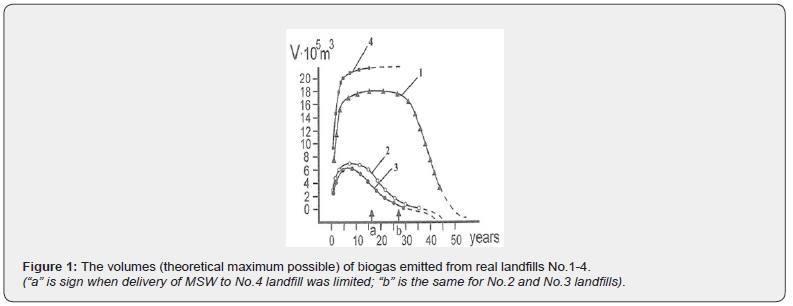
According to calculations [21], world emission of biogas (which greenhouse gas is) from 1990 to 2050 will increase by 9 times (from the real 340 Mt in 1990 up to calculate 2900Mt) – if we will not change relation to the management of municipal waste).
At the depth of 25m, from the bottom layers of mostly “old” No.1 landfill there have been taken samples of “residual” MSW. The age of these MSW layers corresponds to 45 years. The samples were tested for the share of organic components. The average result received on the basis of three samples is the following: the share of organic components - 13.5% (the initial share 45 years ago was about 75% - see Table 1). Thus, during 45 years MSW has been considerably mineralized as a result of a deep biodegradation of organic components of MSW.
In fact, these data have shown: at such landfills as No. 1-2 the process of biodegradation has almost finished, while at No. 3 and especially No. 4 «more young» landfills (see Table 1) are still active. Therefore, we don’t share an opinion [21] regarding “Significant amounts of biogenic carbon may still be stored within the landfill body after 100 years”.
Measurements of biogas (there are, basically, greenhouse gases) emissions at 4 real landfills (from 2m deep borehole) show the following composition of biogas (see Table 2). That is, MSW landfills make a considerable contribution to global warming.


*)MPC - maximum permitted concentration in air of settlements (average daily).
Gases sampled above 1m the real landfills surfaces were tested for dust, hydrogen sulfide (H2S), nitrogen dioxide (NO2), ammonia (NH3), sulfur dioxide (SO2) and carbon monoxide (CO) - see Table 3. These results show that the local atmospheric concentrations above the landfills were often more the norm (especially for dust and NO2). At landfills with smoldering waste - No. 1 and No. 2 - the share of carbon monoxide sharply increases.
However, additional research found that biogas also contains micro-amounts of highly toxic chlorides methane (less 5ppm).
Leachate pollution
None of the four landfills have a leachate collection system. We have analyzed the leachate composition at No. 3 landfill; the data are listed in Table 3. We have studied the composition of underground water the samples of which were taken from the wells surrounding No. 3 landfill. The sampling was done from the depth of about 5-10m.
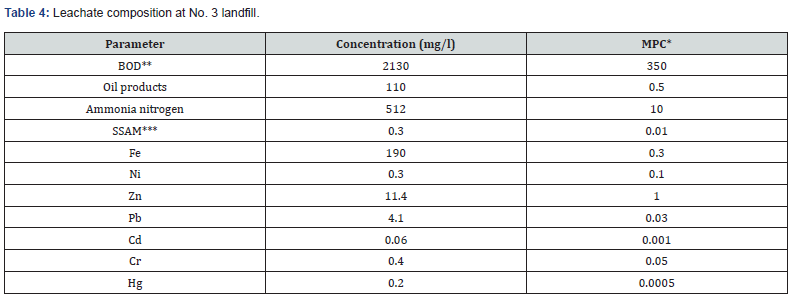
*) MPC- maximum permissible concentration;
**) BOD - biochemical oxygen demand - is the amount of dissolved oxygen needed by aerobic biological organisms in a water;
***)SSAM - synthetic superficially-active materials.
Data of Table 4 demonstrate that the concentration of toxic substances in leachate is in hundreds, and sometimes thousand times more sanitary norms (MPC), i.e., leachate is highly toxic and a very dangerous liquid.
The calculation of leachate volume produced at No. 3 landfill has been done by formula (Eq. 2). If to apply the equation to No. 3 landfill, which occupies 3.1 hectares (Table 1), using R = 200m3/y and the values shown in Table 7, the expected annual leachate volume will be 298m3/y:

The uncontrolled formation of such big volumes of toxic leachate should inevitably worsen ecological conditions of nearby underground water and soil.
For check of possible soil pollution on the border of a sanitary zone (SZ-border) No. 3 landfill (a concentric circle of 500m from the edge of the landfill) were analyzed samples of soil (Table 5).

*) MPC- maximum permissible concentration.
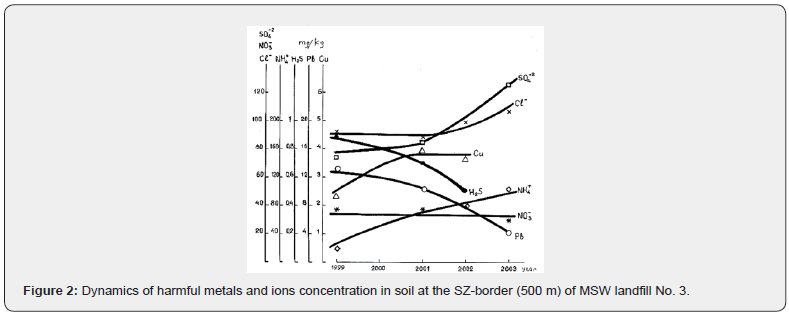
The data of Table 4 & 5 and Figure 2 confirm the worst fears regarding the high danger of leachate from unequipped MSW landfills.
The danger of MSW smoldering processes
For studying of the danger of self-heating and self-ignition of MSW stored in poorly equipped landfills, samples of MSW (in briquettes with density 0.6t/m3) were exposed to thermal destruction in the laboratory device by using of derivatograph as adjustable furnace at temperatures of 70-325°C. (I remind: air was supplied to the “furnace” of the derivatograph - 1L/min; in fact, this is a slow burning of MSW with limited access to oxygen). Results of measurements - see in Table 6 & 7.


We have measured concentrations of toxic gases produced after MSW incineration (including such super-toxic ones as hydrogen cyanide - HCN, hydrogen chloride - HCl, formaldehyde - CH2O) and total concentrations of “heavy” (toxic) metals in the ash (with the help of a mass-spectrometer). After that, we measured the part of heavy metals, which transforms in more “volatile” forms and is emitted into the atmosphere together with combustion gases as well as the part of heavy metals which enter the ash. Besides, we studied a part of heavy metals in the ash, which is “labile” (soluble) and can migrate into soils (if it will be washed out from the ash by rain). The results of the measurements are provided in Table 6 & 7.
By comparing the data of Table 7 we can see that the ash accumulates all toxic metals, excluding mercury and lead: mercury completely evaporates into the air and lead – half-on-half. Therefore, the proposal to use ash after recycling MSW through incineration for building materials [22] causes concern.
So, we have established that during the incineration of MSW the vast emission of toxic gases in the atmosphere will take place. Some parts of each of the heavy metals are taken into the atmosphere together with combustion gases, the other parts enter the ash. At the same time, some parts of heavy metals that have passed into ash are in a soluble form, i.e., they might (in case of precipitation of ash on wet soil) enter into the soil.

*) MPC- maximum permissible concentration.
For check air pollution on the border of a sanitary zone (SZ-border) for smoldering No. 1 landfill (a concentric circle of 500m from the edge of the landfill), samples of air were analyzed (see Table 8).
Evidently, combustion gases from the smoldering dumps have high toxicity (see Table 8) and high danger for environment and human health.
When researchers began to explore burning landfills, even more toxic, deadly compounds were found in the flue gases: hydrogen chloride, dioxin, and furan [23]. Unfortunately, we didn’t study the smoldering dumps concerning dioxin due to the lack of access to reliable analyzers of dioxin. Therefore, the scientific paper [24] well fills up a gap in our studying. At research of influence of the illegal burning dumps in Italy (province of Campania) on the health of local population, it was found high concentrations of dioxins (≥ 5.0pg TEQ/g fat) in sheep and cow milk samples, and also dangerous contamination of dioxin and polychlorinated biphenyls in woman milk samples from those living in Campania (at 16.6pg TEQ/g of fat).
The calculation of the maximum concentration limit Сml (g/s), i.e., the amount of harmful substances emitted by the polluting source per unit of time which will create at the surface layer (at the height of 2m from the ground level) the concentration equal to a maximum allowable concentration of harmful particles in the atmosphere M (considering a background concentration Cb), was calculated using the special computer program.
The calculation was done with the help of the computer software, the results are illustrated in Figure 3. At the border of the SZ (green circle with a red flag) the concentration of one of the most toxic components of fire-hazardous gases – nitrogen oxide – exceeds MPC 16,59 times.
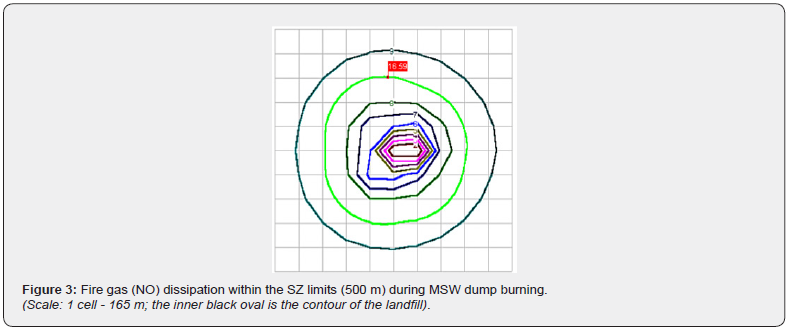
Also, it is necessary to be careful about the activities of waste incinerators. All purification systems for such plants still don’t ensure the safety. So, in Doral, Florida, the plant-incinerator garbage burns approximately 1.000.000 tons of MSW each year, which causes thousands of odors and respiratory issues, complaints [25].
Microbial activity in the unequipped MSW Landfill
Experimental studies of MAFAM (see paragraph 2.5)
We have also conducted experimental studies of this process for the so-called MAFAM bacteria group. In a “close laboratory dump” their population reached the peak after 30 days and then it is decreasing over the following 120 days (see Figure 4).
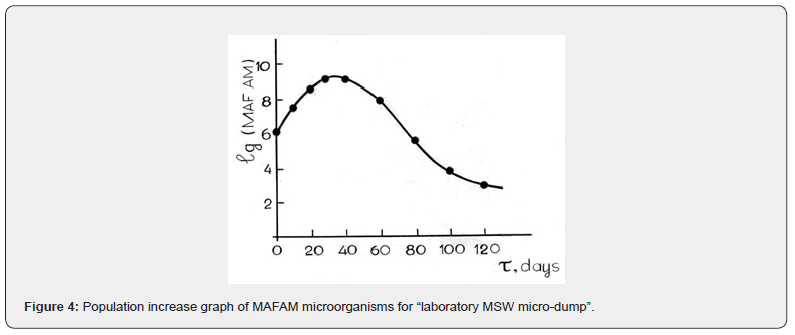
As it can be seen in Figure 4, laboratory results show that the curves of breeding reach their maximum during the first quarter of the MSW biodegradation period.
Toxic and greenhouse gases emission
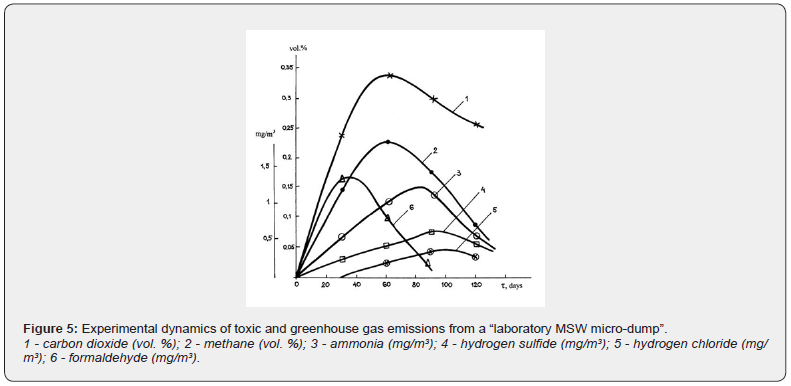
In order to check experimentally the correlation between the dynamics of microorganism colony development within a “closed laboratory MSW dump” and gas generation in this “close laboratory dump”, we have implemented an additional analysis of gas samples within a glass vessel over a MSW layer - see Figure 5.
Figure 5 shows that all toxic gases generated from disposed MSW have maximum at 1/4 - 1/3 of the incubation time. The measurements of the temperature of the “laboratory” dump have shown that during the process of biodegradation the temperature increases up to 50-60°C. It allows us to state that the processes of gas emission from the body of landfills are determined mainly by bacterial activity, and this trend also coincides with the gas emission curves from real MSW landfills (Figure 1).
Smoldering of unequipped MSW landfills and its extinguishing
Since MSW biodegradation reactions are exothermic, there is a potential for self-heating and self-ignition of dumps (which is often the case). From classical thermodynamics, it is known that the process of self-heating transforms into burning when the heat flow (+Q) from exothermic reactions of oxidation exceeds natural heat removal (-Q) from the reaction zone. The interrelation of [(+Q) > (-Q)] often takes place during natural MSW biodegradation processes, especially in summer time - in this extreme case, the temperature inside the landfill can sometimes reach 150- 200℃ (see Figure 6).
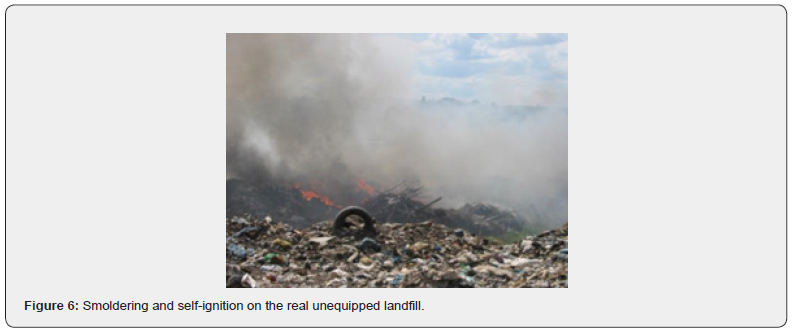

*) MPC - maximum permitted concentration in air of settlements (average daily).
We measured the concentrations of toxic gases at the border of the sanitary zone of a real non-equipped MSW landfill with visible intense smoldering and partial ignition (500 m from the edge of the landfill) - see Table 9.
As can be seen from Table 9, on the border of the sanitary zone of the landfill (this is 500m from its edge!) there is a huge excess of permissible concentrations (from 5 to 15 times) of not just harmful, but extremely toxic gases. This means that smoldering (especially burning) landfills is a high danger, and their smoldering (and even more active burning) should be extinguished as soon as possible. However, ordinary fire engines are unsuitable for these purposes: when the landfill is smoldering, due to the burning out of large volumes of solid waste, huge “hot pits” are formed, and fire engines with a driver can completely fall there.
That’s why we have searched for potential technologies to suppress the activity of bacteria inside the unequipped landfill. “Lime milk” (suspension of Ca(OH)2) has been selected as a simple, safe, and cheap reagent for that goal. We treated our “artificial laboratory MSW micro-dump” with a 10%-Ca(OH)2 suspension at a ratio 0.1 volumes of suspension per 1 volume of MSW. As it follows from Figure 7, after one day (24 hours) after the treatment, the quantity of MAFAM came close to zero (gas emission also stopped and the temperature inside the body of the “laboratory dump” approached room temperature.)
Extinguishing focuses of smoldering at real unequipped MSW landfills can be carried out by pumping special solutions or suspensions into its body – Figure 8. In this case, first of all, the bacterial activity is suppressed, then the smoldering center is cooled. To extinguish smoldering focus in real MSW landfills, we can accept the ratio: 0.1m3 suspension per 1m3 of MSW in the center of the smoldering place [26].
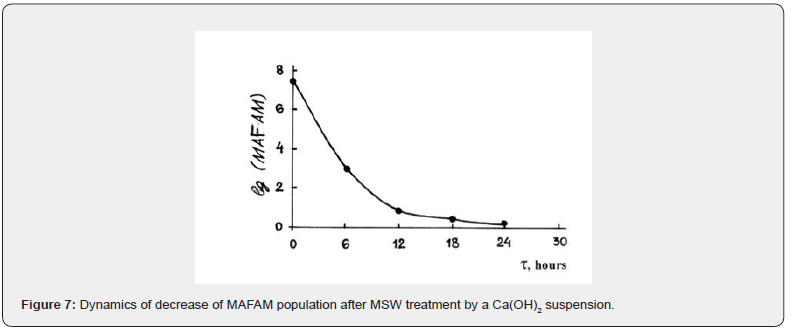
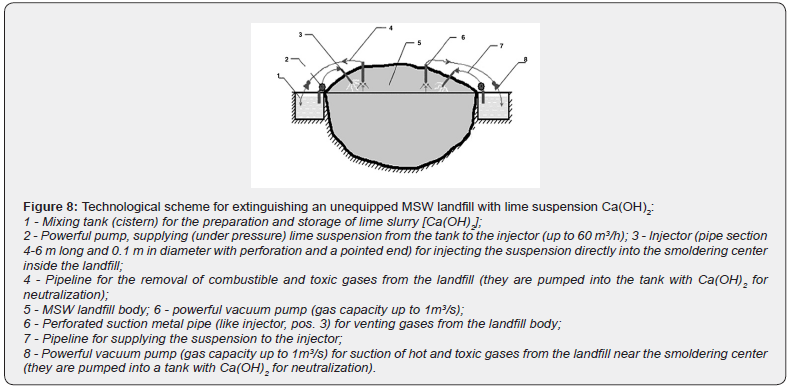
Conclusion and Recommendations
1. Researched MSW landfills are unequipped landfills (see chapter “Introduction”), therefore, they pose a danger to the environment (air, ground, and underground water) and the health of the population of nearby settlements. The general impact of unequipped MSW landfills on public health is well illustrated by Figure 9.

2. The above results of a survey of four real MSW landfills, namely: the emission of “landfill gas” (which is a greenhouse gas), the emission of various poisonous gases, as well as highly toxic flue gases due to bacterial activity in landfill body.
3. The gas emission curves from a “close laboratory dump” of MSW during biodegradation (Figure 4 & 5) and also analogous experimental curves from real MSW dumps (Figure 1) – all of them reach their maximum approximately one third of incubation period.
4. The distribution of emitted by an MSW landfill “heavy” (toxic) metals in air, water and soil has been studied.
5. It is showing a significant role in unequipped MSW landfill biodegradation is played by microorganisms, i.e., they are responsible both for environment pollution of greenhouse and toxic gases and for self-heating of some of landfill areas that often leads to smoldering and even burning.
6. On the border of the so-called sanitary zone of the smoldering landfill (500m around), takes place a significant excess of MPS (maximum permissible concentration) within 5-15 times.
7. It is necessary to arrange a periodical treatment of an unequipped MSW landfill’s “problem areas” with a 10%-suspension of a “lime milk” [Ca(OH)2] to slow down microbiological activity and prevention of MSW landfill smoldering and self-ignition.
8. Thus, a detailed qualitative and quantitative analysis of the biodegradation of both real landfills and its laboratory model showed that an unequipped (or poorly equipped) MSW landfill, in fact, is a dangerous ungovernable biochemical reactor.
References
- Trends in Solid Waste Management. The World Bank report (2022).
- Ferronata N, Torretta V (2019) Waste Mismanagement in Developing Countries: A Review of Global Issues. Int J Environ Res & Rublic Health 16(6): 1060.
- Krasnyansky M, Belgasem A (2005) Pollution of the Environment by Ukrainian Landfills. The 4-th International Congress on Waste Management «WASTE-TECH», Moscow, pp. 577-579.
- de Azevedo TR, Costa C, Brandao A, Cremer MDS, Piatto M, et al. (2018) SEEG initiative estimates of Brazilian greenhouse gas emissions from 1970 to 2015. Nature Scientific Data 5: 180045.
- Sharma BK, Chandel MK (2017) Life cycle assessment of potential municipal solid waste management strategies for Mumbai, India. Waste Management & Research 35(1): 79-91.
- Burdeau C (2020) Italy’s Trash Problem a Burning Issue in the ‘Land of Fires’. Courhhouse News Service.
- Song L, Wang Ya, Tang W, Lei Yu (2015) Bacterial community diversity in municipal waste landfill sites. Appl Microbiol Biotechnol 99(18): 7745-7756.
- Nair AT (2021) Bioaerosols in the landfill environment: an overview of microbial diversity and potential health hazards. Aerobiologia (Bologna), 37(2): 185-203.
- Wang J, Wu C (2004) Biodegradation of Chlorinated Solvents in Bioreactor Landfills. Pract Periodical of Huz Toxic and Radioactive Waste Management 8(2): 84-88.
- Gomez MA, Baldini MD, Macros M, Martinez A, Fernandez S, et al. (2012) Aerobic microbial activity and solid waste biodegradation in a landfill located in a semi-arid region of Argentina. Annals of Microbiology 62(6): 745-752.
- Møller J, Boldrin A, Christensen T (2009) Anaerobic digestion use: accounting of greenhouse gases and global warming contribution. Waste Management & Research 27(8): 813-824.
- Hao Z, Sun M, Ducoste JJ, Benson CH, Luettich S, et al. (2017) Heat Generation and Accumulation in Municipal Solid Waste Landfills. Environ Sci Technol 51(21): 12434-1244
- Council of the European Communities, Council Directive on Waste Landfills (1999) Official EC Journal, 11, p. 182.
- Renou S, Givaudan G, Poulain S, Dirassouyan F, Moulin P (2008) Landfill leachate treatment: Review and opportunity. Journal of Hazardous Materials 150(3): 468-493.
- Siddiqua A, Hahladakis JN, Al-Attiya WA (2022) An overview of the environmental pollution and health effects associated with waste landfilling and open dumping. Environmental Science and Pollution Research 29: 58514-58536.
- Rabinovich SG (1978) Measurement error calculations. Leningrad. Energiya p. 262.
- Gendebien A, Pauwels M, Ledrut-Damanet MJ (1992) Landfill gas from environment to energy. Comission of the EU Communities. Brussel, p. 865.
- Qasim S, Chiang W (1995) Sanitary Landfill Leachate. Technomic Lancaster-Basel, p. 339.
- de Bok F, Stams A, Dijkema C, Boone CD (2001) Diversity of Cellulolytic Bacteria in Landfill. J Appl Bacteriol 79(1): 73-78.
- Gautam SP, Bundela PS, Pandey AK, Jamaluddin, Awasthi Mk, et al. (2012) Diversity of Cellulolytic Microbes and the Biodegradation of Municipal Solid Waste by a Potential Strain. International Journal of Microbiology 325907: 1-12.
- Monni S, Pipatti R, Lehtilla A, et al (2006) Global climate change mitigation scenarios for solid waste management. Technical Research Centre of Finland. VTT Publications, Espoo, p. 118.
- Joseph AM, Snellings R, Van den Heede Ph, Matthys S, De Belie N (2018) The Use of Municipal Solid Waste Incineration Ash in Various Building Materials: A Belgian Point of View. Materials (Basel) 11(1): 141-145.
- Lopes EJ, Okamura LA, Yamamoto CI (2015) Formation of dioxins and furans during municipal solid waste gasification. Brazilian Journal of Chemical Engineering 32(1): 26-34.
- Mazza A, Piscitelli P, Neglia N, Rosa GD, Iannuzzi L (2015) Illegal Dumping of Toxic Waste and Its Effect on Human Health in Campania, Italy. Int J Environ Res Public Health 12(6): 6818-6831.
- Peischel W (2022) “Is It Time to Stop Burning Our Garbage?” Bloomberg, May 23.
- Manfredi S, Tonini D, Christensen TH, Scharff H (2009) Landfilling of waste: accounting of greenhouse gases and global warming contributions. Waste Management & Research 27(8): 825-836.






























